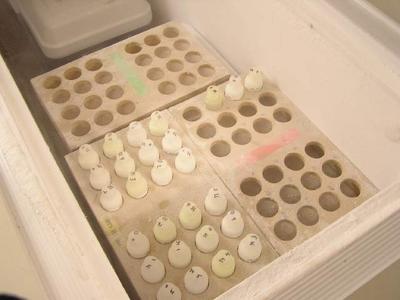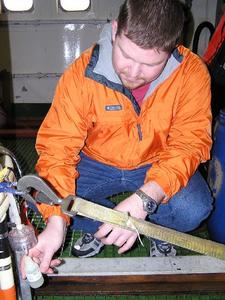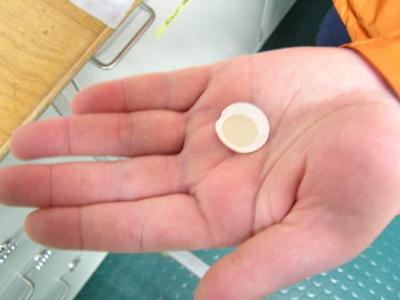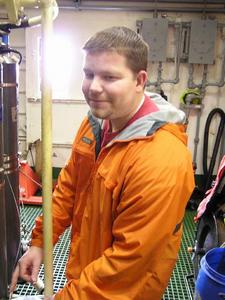31 July, 2003
Perhaps I shouldn't admit this, but the most fascinating part of this
cruise has not been the science, but rather, the people. Oh sure,
this icy seascape where you never know when you may see the next bear
or walrus is pretty exciting, but for me, it's the people that I'll
remember the most when I return home. A group on board that never
ceases to surprise me, for example, is the four graduate students
that are part of the science team. Compared to the "old salts" with
numerous voyages already behind them, these highly capable and
enthusiastic young scientists are in the beginning stages of their
promising careers.
One of these very memorable "oceanographers-in-training" is Jeremy
Mathis from east Texas. Simply put, he enjoys everything about the
sea. Jeremy's passion for sailing and SCUBA diving led him to study
oceanography. An undergraduate degree in chemical engineering gives
Jeremy a solid foundation in the physical sciences which will come in
handy as he pursues his Doctorate at the University of Miami under
the supervision of Dr. Dennis Hansell in the Marine and Atmospheric
Chemistry Division.
This is Jeremy's first major oceanographic cruise and he's determined
to make the most of it. To this end, Jeremy is doing everything he
can to help the science team achieve their goals. Depending on the
time of day, you can find him directing and monitoring a CTD cast
from the dry lab, or drawing nutrient, salinity, and oxygen 18
samples from the rosette in the Baltic Room.
But there's much more. Jeremy is responsible for two kinds of
samples that he will describe in own words:
1. Dissolved Organic Material Samples or DOMS- These
samples will be analyzed for the amount of dissolved carbon and
nitrogen that they contain. This is useful in identifying different
water masses and their interactions along the Arctic Shelf Basin. To
catch these samples I use an in-line filter called a drip filter to
obtain approximately 50-mL of water from the Nisken bottles on the
rosette. Once I have drip filtered the sample into a container it is
placed in a minus 80 degrees Celsius freezer for the duration of the
cruise. This is necessary to preserve the sample for its long trip
back to Miami. DOM Samples are being taken at all stations where the
water depth is less than 250 meters. Each sample is obtained from
the deepest depth of the cast; and,
2. Parcticulate Organic Material Samples or POMS- For
these samples I catch 1 liter of water directly from the rosette and
filter it using a special filtration device back in my lab. After
all the water is filtered I recover the filter pad that contains all
of the organic material that was suspended in the water. The water
is disposed of and the filter pads are dried to preserve the material
that is on them. These are then also placed in the freezer for the
return trip home. These samples were only taken during a special
section of the cruise called the East of Barrow Canyon Section.
During previous cruises sampling has indicated that there are several
interesting features occurring near the East of Barrow Canyon Line.
By doing an in-depth study of the area (approximately 260 samples), a
better understanding of the area will be obtained.
If that's not enough to show how highly motivated Jeremy is consider
this: during the east Barrow Canyon stretch of our cruise, he worked
around the clock for three-plus days! While the rest of us enjoyed
easy 12 hour shifts, Jeremy worked continuously to obtain and filter
his POM samples, catching only a few cat-naps between stations. And
when I inquired about how he already knew so much about oceanography,
Jeremy sheepishly described several books that he had read in
preparation for the trip. I recognized one of the titles- a
descriptive physical oceanography text- as it had been recommended to
me by Chief Scientist, Jim Swift. The difference being that Jeremy
has not only read it once- but twice- while I'm still working on
chapter 4 (which is not even close to the end).
Better than reading about oceanography, however, is the opportunity
to practice it first-hand. To be at sea with the likes of Dr. Swift
and the rest of the science team and technical staff is giving him
experience that no amount of reading can do. And that's what Jeremy
is most excited about for the practical knowledge gained on this
cruise is what he can take home and apply to his studies. If you
travel or read about the oceans I suspect this won't be the last time
you hear about this impressive oceanographer to be.

Jeremy discussing cruise plan with Chief Scientist, Jim Swift and Data Processor, Marie Beaupre.

These DOM samples take only a few minutes to freeze solid at minus 80 degrees Celsius.

Graduate student Jeremy Mathis collecting a DOM sample from the rosette.

Jeremy filtering a POM sample.

POM sample- look closely and see a faint discoloration by the parcticulates on the filter paper.

Jeremy Mathis of the University of Miami collecting yet another sample.
Contact the TEA in the field at
.
If you cannot connect through your browser, copy the
TEA's e-mail address in the "To:" line of
your favorite e-mail package.
|
